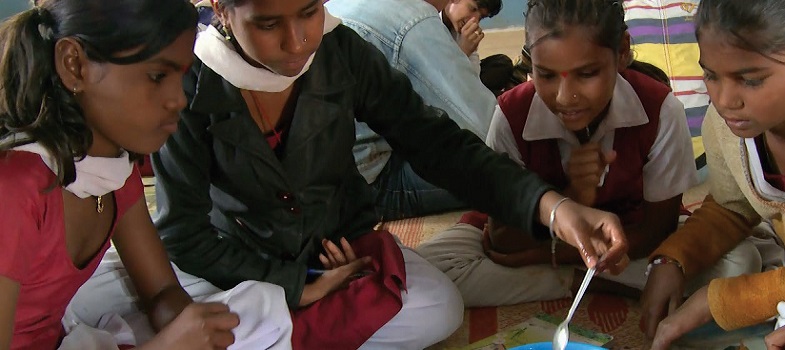Resource 3: Activities to encourage speaking and listening in English
(This is an extract from Krishna Kumar’s book The Child’s Language and the Teacher.)
These are just some of the dozens of activities any teacher can organise in any ordinary classroom. Each time an activity is repeated with some little change, it will be received with even greater enthusiasm by the children than it got last time. So do each activity any number of times, adding something new each time. Keep a record of the variations so that you can introduce your innovations to a new colleague. Nearly each activity described here can become the starting point of a dozen variations.
1 ‘What Did You See?’
Stage 1: Ask one child to go out of the room, see what is happening outside, and tell the class what he saw. For instance, he might report that he saw a truck, two shops and a bicycle.
Stage 2: Now the rest of the children, preferably sitting in a circle, will ask him questions, one by one, and one question per child. For instance, a child may ask: ‘What was hanging from the bicycle’s handle?’ The reply may be: ‘A basket.’ The next question may be, ‘What colour was the basket?’
Stage 3: When one round of questioning is complete, the teacher will ask the child who has gone out: ‘Who asked the best question?’ Supposing he says, ‘Shashi asked the best question; the teacher will ask: ‘What was the question?’
Stage 4: The next round starts with Shashi. Ask her to see something that the earlier child had not seen. When she comes back, ask children to come up with new questions – not the ones they have already asked.
2 ‘Asking the Explorers’
Send a small group of children, no more than five or six, to study some specific object or place near the school or even inside the school building. For example, they may be sent to examine a cluster of trees, a tea stall, a broken bridge, or a nest. Ask them to explore it carefully and discuss among themselves everything they notice.
While the explorer group is away, tell the rest of the class about the object in some detail. For example, if the explorers have gone to examine a tea stall, tell the class about the things available at the stall, who runs it, where do the things available there come from, etc.
When the explorer group comes back, it will face questions from the class. The teacher can also have her turn. Next time, send a different group.
3 ‘Guess What I Saw’
One child goes out, stands at the door or at some distance from the class, and selects one of the hundreds of things she sees around (it could be anything – tree, leaf, squirrel, bird, wires, pole, grass, stones). When she comes back, she says just one sentence about the thing she has in mind. For example, she might say, ‘What I saw is brown.’
Now every child in the class gets one chance to ask more about the thing and guess what it was. For example, questioning may go like this:
Child 1: ‘Is it thin?’
Answer: ‘No.’
Child 2: ‘How big is it?’
Answer: ‘It’s quite big.’
Child 3: ‘Is it as big as a chair?’
Answer: ‘No, it’s smaller than a chair.’
Child 4: ‘Can it turn?’ …
Finally when the thing has been guessed correctly, some children may object to the answers they got for their questions. For instance, someone may point out that the colour was not brown but clay-like. In such situations, the teacher’s role is very important, as someone who can help children establish subtle distinctions between meanings.
4 ‘Doing What Was Said’
Ask children to listen and do what you tell them to do. Start with simple things to do, and ask the whole class to do them together. Examples:
‘Touch your head.’
‘Close your right eye.’
‘Clap on your head.’
Divide the class in two groups. The teacher will give instructions to the first group, and the children of this group will now give similar instructions to the second group. Gradually make your instructions more complicated, for example:
‘Touch your head with both hands, then touch your right ear with your right hand.’
‘Close both eyes, touch your neighbour, ask him to give you his left hand.’
When children of one group give instructions to the other group, they need not repeat everything they have heard. Encourage them to make up new instructions.
5 ‘Comparing’
Make sets of similar-looking things, such as leaves of two or more trees, flowers of different plants, stones, pieces of paper cut in different shapes, etc.
Ask children to listen to the description you give of one of the things in a set, and on the basis of the description they must decide which one you are thinking of. Example:
‘I’m thinking of a leaf that is smooth and long, and it has even edges.’
After doing this activity a few times, ask children to take turns to choose and describe. Change things each time you do this activity. Identify more subtle features each time.
Resource 2: Two English language games
